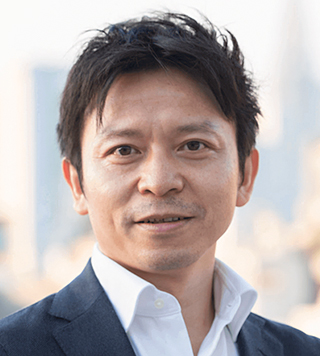Video ProfilesResearch
October 2023 Issue
Artificial intelligence for energy, materials science, and quantum computing
Tomah Sogabe
Associate Professor, Faculty of Informatics and Engineering,
Tomah Sogabe’s research focuses on integrating cutting-edge AI techniques into three key research areas: energy optimization, device design, and quantum computing. The primary objective is to create automatic control systems and design schemes that tackle tasks too complex for human knowledge alone.
In AI-based smart grid optimization, Sogabe's research group has successfully developed an ensemble deep reinforcement learning algorithm. This algorithm trained multiple learning agents to handle a wide range of weather scenarios, simulated through a global weather forecasting package. The trained agents not only learned optimal policies but also provided risk evaluations for decision-making processes.
In device design, Sogabe’s group has excelled in optimizing transparent solar cells to maximize efficiency, transmittance, and device lifespan. Traditionally, device optimization relies on trial and error, but the design complexity is beyond human capabilities, with over 30 parameters requiring optimization. The AI-based approach explored and optimized molecular structures with specific absorption profiles, ensuring maximum light absorption and visible light transmittance. This was accomplished using time-dependent DFT atomic simulation and reinforcement learning to predict and optimize molecular structures, resulting in optical absorption profiles closely resembling the target profile.
Finally, Sogabe and colleagues have demonstrated the applicability of AI technology in quantum circuit design, considered one of the most challenging aspects of advanced quantum computing. Quantum circuits exhibit intricate features such as high dimensionality and non-linearity, aligning well with AI's strengths. The integration of AI and quantum computing proved highly synergistic, facilitating the generation of target quantum states and the creation of robust and reliable ansatz states with minimal molecular energy.
References and further information


1. K. Kitamura, H. Nomura, Jpn. J. Appl. Phys. 62, SJ1013 (2023).
https://doi.org/10.35848/1347-4065/acb559
2. H. Yoshida, T. Sogabe et al., AIP Advances, 12, 115316(2022)
https://doi.org/10.1063/5.0127546
3. T. Kimura, T. Sogabe et al., Journal of Physics Communications, 6 (7) 075006 (2022)
https://iopscience.iop.org/article/10.1088/2399-6528/ac7d39/meta
4. K. Shiba, T. Sogabe et al., Japanese Journal of Applied Physics, 62 SK1046 (2023)
https://iopscience.iop.org/article/10.35848/1347-4065/acd34f/meta
5. T. Sogabe et al., Mathematical Problems in Engineering, 21, 3511029 (2021)
https://doi.org/10.1155/2021/3511029
website
https://cluster-iperc.matrix.jp/


